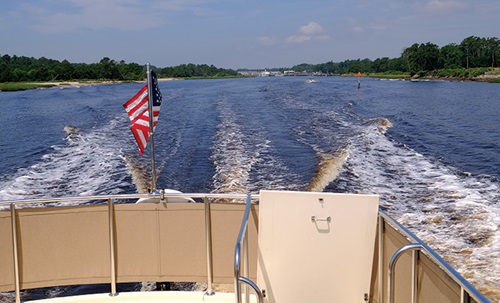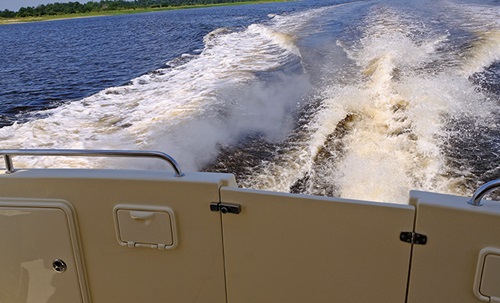Advertisement
A Reader Suddenly Has Trouble Getting His Boat In Trim. Here’s What Our Technical Editor Recommends.

Tom’s boat, Chez Nous, is getting up, close to a good plane, but not quite there yet. Photo: Mel Neale

Chez Nous just beginning to dig out. Note the walls to the hole behind her. Photo: Mel Neale
I have a Larson 274 Cabrio with a 5.7-liter engine and never had an issue getting it up on plane – until recently. We added a significant amount of weight for a trip, primarily in the stern. Although I had the throttle all the way forward, the boat could not get up on plane. When the boat isn’t on plane and the stern is still under water, if I engage the trim tabs (both bow down), will this help lower the bow and help get up on plane, or will it just create more drag and make the situation worse? Thanks for your help! Kenneth Gutt, New York
TOM NEALE: A lot of people ask questions about trim tabs and weight loading, so let’s really get into it in this issue. Trim tabs can be incredibly helpful but can cause problems if used for the wrong things. To your question, it’s probably much better to unload some of that weight, or maybe carefully shift some of it forward, if doing that doesn’t make the bow go down or make the boat otherwise unstable. It isn’t unusual for a boat with too much weight to be unable to dig itself “out of the hole.” Sometimes it takes very little weight depending on the boat, motor, and prop. Solving your problem with trim tabs alone will probably, as you wisely surmise, cause too much drag and may be unsuccessful. Your boat is trying to tell you something.
Boats are designed (or should be designed) with weight tolerances and load locations in mind. Exceeding these as to amount and placement can cause instability and be dangerous. It can even cause the boat to capsize or swamp when you’re not expecting it. Check your boat’s load specifications. Even if you’re within your limits, if all that weight is in one place or on one side or one end, you may still have problems. Err on the conservative side. Things can go bad quickly with an overloaded or poorly loaded boat.
Powerboats under 20 feet (I understand yours is longer) should carry the loading information on a capacity plate, which includes the maximum number of adult persons, the maximum gross weight, and other information. You could also try calling the boat’s builder. Our BoatU.S. Foundation also offers guidance: BoatUS.org/study-guide/boat/capacities.
Visit dco.uscg.mil/LLLength for the official U.S. Coast Guard formula for determining maximum persons aboard.
It’s best to get the boat on an even keel at the dock before you leave and, depending on your boat, perhaps tell people to “stay put” while you’re underway. Sometimes much can be accomplished by judiciously and safely moving weight about, whether it’s people, coolers, cargo, or whatever. Even having done that, you may not be able to get up on a plane because of inadequate power of your engine or prop. “Trimming” the boat with trim tabs often doesn’t make up for poor loading, and trim tabs shouldn’t be considered the only solution.
It’s not unusual for many boats to run with the bow up a little, depending on various factors, even though the boat may seem to be balanced at the dock. For such situations, trim tabs can help to get the bow up or down. They can also give you a faster and more comfortable ride and save fuel by preventing the boat (either bow or stern) from digging into the water causing more resistance.
When you reach speed, and even as you’re beginning to reach it, glance at your wake. Usually, a well-trimmed boat will throw the least amount of wake at the intended speed and the boat’s wetted surface should be reduced. Also, as you fine tune your trim, you may find your boat speeding up a little.
As you fine tune, remember you’re on the water, not land, and this makes a difference. For example, lifting the port stern with uneven trim tab operation may have the effect of lowering the starboard bow. This is seldom a desired goal. Also, as the bow goes up, the stern may dig in more, resulting in lower speed and squatting, and perhaps impaired line of sight ahead. Every boat is different, so check yours at different speeds to see what’s best.
Typically, the bow will go up as a matter of course as you try to get out of the hole. And the trim tabs can be used to bring the bow down. This should get you less resistance and more success at getting out of that hole. Once you do get “up,” the trim tabs can be used to stay on a plane, again with less resistance. However, if you slap into a wave, its force may knock back your speed and knock you off the plane. Trim tabs can help here.
While trying to get up, many skippers will ask passengers to move forward to bring the bow down. This is seldom ideal for safety and stability reasons. It’s usually better to use those tabs and not have passengers moving around the boat. Using trim tabs properly can make your boating safer.
Trim Tabs Are Helpful For Other Reasons
Sometimes when I’m running into a nasty chop with a lot of spray, I’ll use the tabs to deliberately bring the bow up a bit so that as I come into the waves, the bow will squash them. This takes a little bit of adjustment, isn’t always desirable, and doesn’t always work, but I’ve used this tactic, carefully, for years. Of course you can overdo it, but it doesn’t take long to get the feel and get it right. A downside of this could be unnecessary pounding. If I’m running into an inlet with a following sea, I may use the tabs to keep the bow from digging in as a wave comes up astern. But this takes practice and experience, and it’s probably much better to choose another time and sea state.
Some folks will use the tabs to keep the boat from listing to one side or another while running. If your boat is running one side down, it may be very unstable even though you may not realize it. If bad enough, this could cause you to flip before you know it. I’ve even known people to deliberately load so the boat lists. They then use the tab on one side or the other to get an even keel. Don’t. It’s not what they’re intended to do. If you want to heel in a sailboat, that’s another matter; but they’re built very differently from typical powerboats.
It’s important to remember, particularly when running on tabs unevenly adjusted, that a sudden change in speed without changing the tabs can result in a sudden change in the boat’s trim, which may cause serious problems.
More Ways To Improve Trim
- Check your horsepower. You need an adequate motor for the boat and design of the boat’s hull.
- Consider a prop change. You may benefit from changing your prop to one that provides more power for digging out of the hole. A good prop shop or advice from the manufacturer may help with this.
- Clean your trim tabs. They’re usually made of metal and sometimes collect barnacles or even oysters if the boat isn’t used a lot. Antifouling paint seems to have a hard time sticking to metal, although I’ve heard there are some good paints out there that will. It’s important to have the trim tabs inspected, cleaned, and painted when you get hauled. And when you’re swimming around the boat at a beach, inspect and clean them if safe to do so.
- Check for mechanical issues. Most trim tabs are operated by hydraulics with the reservoir and motor inside the hull and the rams outside. Sometimes a hose, ram, or other component will spring a leak. At first you may not notice a change in the operation. But if you see signs of hydraulic fluid in the water or in your stern, or if one tab is operating differently from the other, take care of it right away because it won’t take long to have the system totally inoperable. This could range from replacing O-rings in the ram to replacing a hose or a tube, or just tightening a fitting. If you’ve lost fluid, replace it with what the system manufacturer recommends, and be sure to track down the leak. — T.N.
Using Your Outboard To Get Out Of The Hole
I’ve been referring here to the two trim tabs attached to the stern. You can activate these up or down with a switch at the helm. But there’s another way of trimming if you have an outboard motor. Typically, the trim/tilt will tilt the motor up a little thus bringing the bow down.
This can also be helpful if used properly. With either method it’s a good idea to learn the position of the tab or motor that gets the most benefit at your typical running speeds. Usually there are gradation marks or a digital readout to help with this.
As you’re probably seeing, learning how to best use trim tabs for your boat has a lot to do with your feel for the boat. When the boat is running at the best trim it will probably feel so. Often we see boats plowing down the river throwing maximum wake and guzzling maximum fuel with a worried look on the faces of skipper and passengers, wondering what’s wrong.
Get Out And Play
There are different types of trim tabs and other issues than what I’ve discussed here. Whatever type you have, always read the literature and instructions, and ask the manufacturer if you have any questions or concerns. Remember, common sense should never be left ashore. Individual boats, different loads, different sea conditions and speeds will probably feel different with other boats as you handle them.
This is good news, though. It means that it’s beneficial for you to go out and get the feel for your boat. Carefully play with the boat. Watch her wake. Try her out. Put her through some paces when and where it’s safe. If you’re careful and take your time, it’s fun. You’ll love it.
When you’re running at the right trim, most boats have a beautiful V wake, not too high, which tells you everything’s right. Learning the feel of a boat is a beautiful thing!
